'Leadership is about making significant change happen at a human level. It’s also about making a difference.'
Preface
Leadership is a key skill for General Practitioners. We are all leaders within our teams. Becoming better leaders can help us to deliver excellent patient care. Learn more about yourself and about leadership in this webpage with content from Dr Amar Rughani, Samantha Wong and Liddy Mawer. I highly recommend this article.
Nicholas Boeckx
TPD Coventry and Warwickshire
Amar Rughani, Samantha Wong, Liddy Mawer
Dr Rughani would be interested in your feedback. Share your thoughts on leadership with him via twitter @AmarRughani
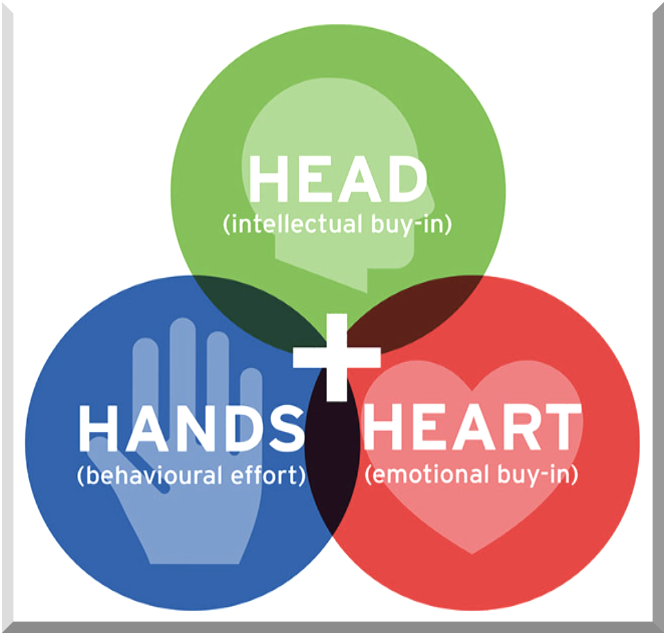
(The Head, Heart and Hands model of employee engagement is intellectual property of Edgecumbe Consulting Group Ltd.)
When changes are small-scale and don’t involve many people to a great degree, leadership is not needed.
However, most of the challenges that we face in primary care are complicated and involve many people.
The context that we are working in is complex for 2 reasons. Firstly, there often isn’t an obvious way forward and many factors have to be taken into account. Secondly, the issues affect real people and in this age of global communication, these people are in touch with each other and expect to be involved, not just informed.
To help people work through complex problems, we need leadership that is able to work with people and facilitate the process of change.
The significant change is made by the whole group, of which the leader is a part. The leader contributes to the group effort by being a driver of change.
Leadership is also about making a difference, which every human being has the capacity to do. Tragically, too many people do not feel that they are of account or that their thoughts and ideas might help the team to develop. This is wrong. Nobody is nobody. Part of our challenge as leaders it to change the culture so everybody recognises that potential and the opportunity to make a difference.
If change is made by a team, what skills do the team need?
This intuitive diagram shows that we need a combination of head, heart and hands skills, in other words thinking about what we need to do (head), relating to people so that they feel involved (heart) & doing stuff to make change happen (hands)
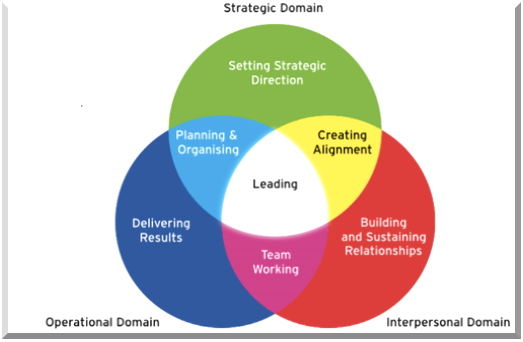
(The Primary Colours® Model is a registered trademark of Edgecumbe Consulting Group Ltd. Used with acknowledgement.)
This slide is called the primary colours® model of leadership developed by David Pendleton et al. It gives the head, heart and hands different names in terms of the tasks needed to be accomplished for change to happen. (Pendleton, Furnham and Cowell, 2021).
We can always think of this as a clockwise circle starting with the green area.
Green Zone
Change often happens by thinking about what needs to change and why, what the options are, what is going on elsewhere that we might learn from, what the literature says et cetera.
Once ideas have been developed we move into the red area in which they are discussed more widely in the workforce. This process will involve engaging with people, hearing their thoughts, encouraging them to challenge the ideas to make sure that they are robust. Through this process, 'alignment' is created between what the people feel they are prepared to do and what the thinkers suggest we need to do. Without alignment, we can go no further. If we try to force the issue and tell people to comply, the project will fail.
Red Zone
In the red zone, there is much to do with building and maintaining relationships. Here, people need to be nurtured, involved and supported in their new or modified roles.
Working with people is not just about being nice to them or nurturing them. Because we have to deliver results, the clockwise arrow moves into the delivery zone. In the overlapping area labelled 'team working' we have to encourage and sometimes push people into meeting agreed objectives.
Blue Zone
In the blue zone, people and projects are managed so that results are delivered.
The final overlap is between thinking and delivering, which is a zone in which the vision of the thinkers is converted to a timeline and specific objectives through the process of planning and organising. This requires thinkers and manages to work closely together.
Complementary Skills
The primary colours® model shows the skills that are needed for change to happen. The most important thing to remember is that these skills have to be present within the whole team. This does not mean that all the skills can be present within one person. In fact we know from the studies of effective leaders, nobody can be skilled in every area to an exceptional degree. The reason is that to be good in some areas, necessarily means that you will be less good in others.
Think of Jessica Ennis the heptathlete who has the ability to be very good at running and jumping. She is not so good at throwing. However, Valerie Adams from New Zealand is the opposite. If Jess tried to develop the muscles that Valerie has for throwing the shot put, she wouldn't be able to hurdle and would be mediocre at everything rather than exceptional at some. Its pointless asking which of them is the better athlete. The main thing is that they are both world-class because they have worked on their natural strengths to be the best that they are capable of. That's the challenge for us. We need to understand ourselves far more deeply, so that we can work on our strengths and be the best John, Sue, Deepak and Li that we can. This is not an egotistical exercise. By being the best that we can be, we contribute hugely to the effectiveness of our teams. We become Team GB not just Jessica Ennis.
Must Leaders Be Equally Skilled In All Domains?
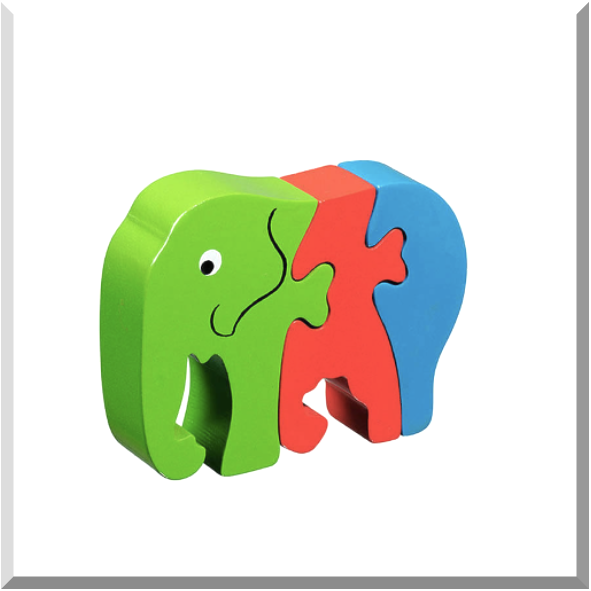
So here's an insight. The process of change that requires the whole team needs the input of people who are in themselves incomplete. Rather than feeling bad that we are not 'complete' as individuals, we should celebrate our ability to be exceptional and more importantly, make sure that our teams are made up of people whose abilities complement each other.
Another way of looking at this, is that such teams are made up of people who see the world in different ways. As humans, we tend to gravitate to those who are like ourselves and often think negatively of people who view the world very differently. As leaders, we need to recognise that the views of people who are quite different from ourselves are not only important, they are vital if we are going to improve the world. This means that we have to start learning to value these people. At the start, this might mean that we stop feeling so irritated by them because we know they potentially have an important part to play. Later, when we work with them we witness what they have to bring and we learn to appreciate this. This makes us less resistant and ultimately, these people become our friends and we naturally include them because we value them and what they have to give. The great hope is that this feeling becomes mutual as diverse people learn not to fear others or be suspicious of them, but to appreciate that diverse perspectives when used to a common purpose, make us all much stronger. In spiritual terms, we are all different and unique manifestations of the same human spirit, which makes each of us equally valuable.
We need to try and understand ourselves better, so that we can work on our strengths and be the best that we can be. In addition, understanding ourselves better is the start of understanding others.
Tests of Self
Link To The Belbin Team Roles Inventory
Link To The Personality Inventory
Before continuing it will help if you complete the Belbin Team Roles Inventory and The Personality Inventory. Links to both are given above
The personality test that you have done will show you how you stand in relation to 5 axes. The data from which this survey is drawn is based on large populations and therefore says something about people in general, rather than you in particular. No test will never tell you the truth about yourself, so when you find yourself getting irritated or disagreeing with the outcomes, remember that point!
It is said that these five dimensions of personality are relatively fixed in early adult life. Personality does not mean that you necessarily behave in these ways. It simply gives you a critical insight into what your personal biases are. More specifically, the test shows you how (unless you choose to do otherwise) are inclined to think, feel and act. We therefore find that the manifestation of our personality will be different depending on who we are with, what we are engaged in, how we are feeling physically or emotionally etc. This doesn’t mean that our personality keeps shifting, it just means that our behaviour is different. Understanding our personality and therefore the biases that are just part of who we are, is the key to being able to knowingly change our behaviour and in time, change our attitudes, so that we are more effective and ‘better’ people.
The words can seem a bit pejorative, for example 'neurotic'. Just take these words as labels, rather than value judgements.
Here are a couple of important points:
Each of these labels is a characteristic that is valuable. Each of the characteristics is valuable no matter where on the scale do you happen to be.
Have a look at your personality results and discuss these questions with a friend who understands you. It's natural to feel irritated, upset et cetera with some elements. There may also be some elements that you feel quite pleased about.
Because there is no such thing as a good or a bad personality, the object of this exercise is to help you understand yourself and accept yourself for who you are. Of course, this won't come from a personality measure alone, many other things will contribute to your growing understanding of the person you are and by improvements in behaviour, the person you have the capability of becoming.
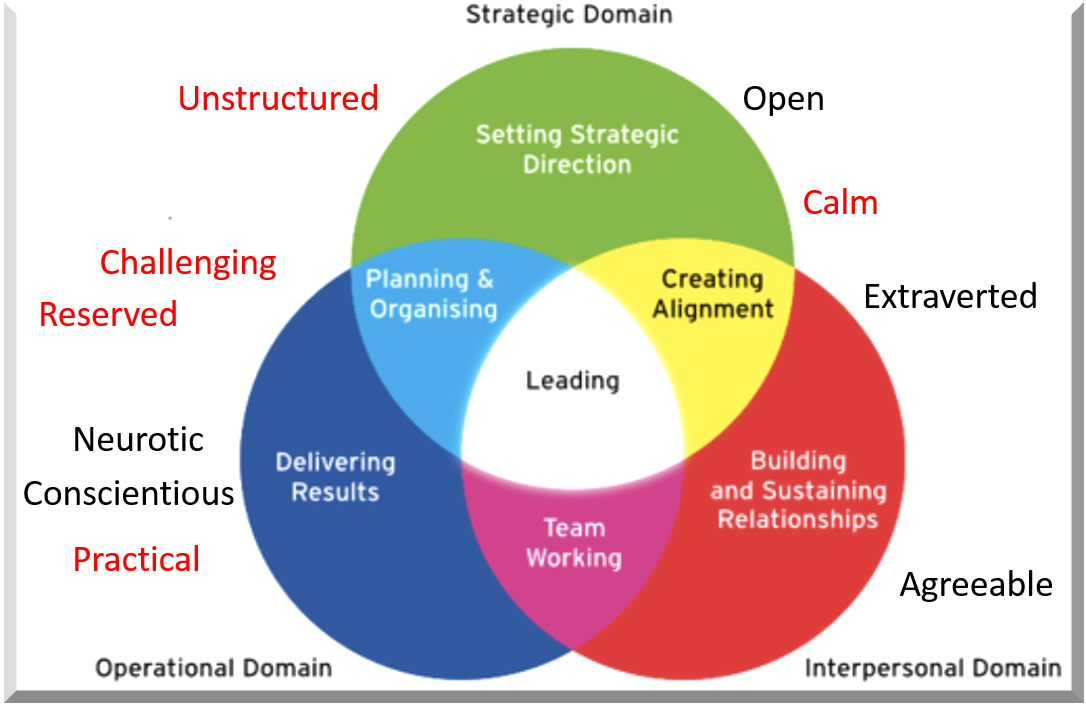
In this slide, I have used red labels to indicate a characteristic of those at the low-scoring end of each of the Big 5 personality characteristics, hence
Open….Practical
Conscientious….Unstructured
Extraverted….Reserved
Agreeable….Challenging
Neurotic…..Calm
Now let's look at each of these words, which represent the extreme end of each scale, and think about how each characteristic, whether scoring high or low, is a strength because each of them contribute something to the range of skills that leadership requires, as shown by the primary colours®.
I've offered some ideas here, but there are many other legitimate viewpoints about how this characteristics might help the process of change and which main colours you might attach them to. This is simply a personal viewpoint.
Open: Green
This reflects imagination, the ability to think critically and to reflect. Open-minded people seek variety and change and are good at thinking afresh about problem areas
Practical: Blue
At the opposite end of the 'openness' scale, people prefer to be practical, concrete and down-to-earth. They are good at getting on and delivering.
Conscientious: Blue
This people have high standards and a high level of focus on achieving goals. They are well organised. They are therefore excellent at delivering and in particular at contributing to planning and organising.
Unstructured: Green
The other end of conscientious can seem like a negative area in that people can be a bit disorganised and not particularly reliable. However, there is strength here because such people don't invest much in being structured and limited by boundaries. They are therefore more inclined to show openness and contribute to the creative blue sky thinking that is needed in the green area.
Extroverted: Red
Extroversion is principally a people-orientated characteristic. Such people prefer to be around others and derive their high energy from social interactions. Sometimes other people, particularly introverts, can find them pushy, dominant and draining. However, this sociability helps in the red area. Their energy and drive can also help with creating alignment and with team working.
Reserved: Blue
Reserve people prefer to be alone or quiet. This helps to balance the energy in the group. Importantly, being reserved aids reflection which can contribute to the green area, where insight and balanced judgement are important. In addition, being reserved may help with concentration and focus, with benefits to the blue area of delivery.
Agreeable: Red
Agreeable people help usually in the green area. They are keen to please and are cooperative and sympathetic. They therefore help to sustain motivation, which is a key factor to success in the long haul hope achieving significant change. They tend not to be comfortable with standing up to people and will avoid conflict. On the other hand, this helps their natural ability to be diplomats and to help people compromise and work towards a negotiated solution.
Challenging: Green, Team Working & Blue
Challenging people may not be easy to live with, but they are indispensable. Being challenging does not mean being destructive. We are talking here about 'constructive dissent’. In the green zone, challenge can ensure that there is a brake on the process. This is important to ensure that there is a balanced discussion and that people don't get carried away with wild ideas that might be dangerous or might not be feasible.
In the team working and blue zones, Challenge can ensure that we keep people to task, rather than just support them in an unquestioning way. Apart from performance management, challenge can encourage people to develop by encouraging them to perform well in their current roles and also encourage those that already perform well, to avoid complacency and to extend themselves and improve further. These messages are usually not easy to hear as most of us enjoy being in our comfort zone! People who challenge may not be popular, but most people respect them as they recognise subconsciously that they are contributing something important.
Neurotic: Blue
A high score may sound pejorative and maybe the word itself is unfortunate because of its connotations. However, people with this characteristic are sensitive to detail and feel the effects emotionally if detail is not given due attention. Therefore, they are great at obsessing over small details and making sure that the 't's are crossed. This sort of detailed work, like reading the fine print, would drive other personality types mad and yet it is essential if tasks are to be completed to a professional standard.
Calm: Green & Red
Low scores on the neuroticism scale indicate a relaxed and calm demeanour, for example being good in a crisis or when under stress. In the green zone, this can be good at encouraging a dispassionate view, weighing up pros and cons and not getting carried away. This can encourage good balanced judgement. In the red, people, area, calm people can help to defuse situations that are becoming emotionally charged. For example, the thought of significant change is always associated with anxiety and fear in many team members. Calm people can help to stop their colleagues from going off the rails or making decisions, for example about their own future in the organisation, that might be rash.
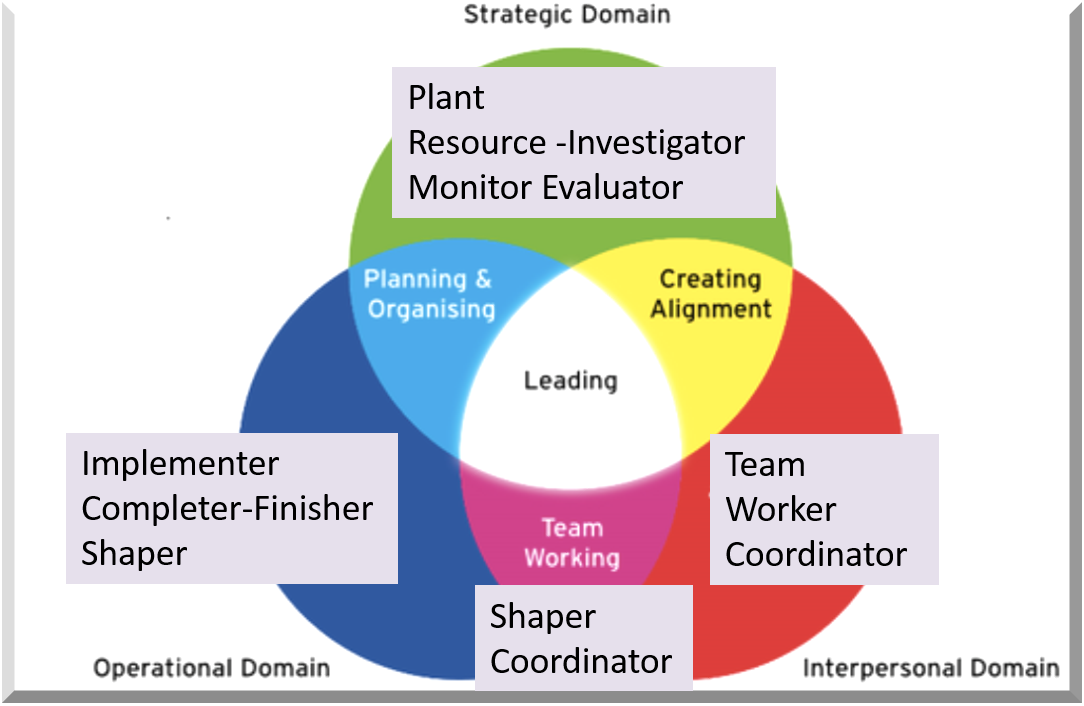
This slide shows the roles that people find themselves in. The questionnaire that you have completed gives you an idea of your role preferences. Probably the top two or three preferences are the most important for you to consider. In addition, you can get an idea of whether one type is dominant in your make up. Of course, the role that you feel comfortable in may change during the course of your career, for example in response to the work that you have to do or in response to the development of your skills and attitudes. Here is a thumbnail of the different roles:
Shaper: Team working & Blue
These people need to achieve and have a strong drive. They can overcome obstacles and even thrive on confrontation. They will challenge inertia and complacency and in doing so, have a tendency to offend others. They are particularly helpful in management roles, where their drive and courage helps the team to deliver.
Coordinator: Team working & Red
These colleagues are good in relationships, are able to spot talent and place people in positions where they can contribute to the common goals. They are good at delegating and keeping people on board. They are not dominant people and don't have pretensions about their intellectual or creative ability.
Plant: Green
This people are individualistic, serious minded and often unorthodox. They are innovative and can be highly creative, providing the seeds of ideas from which major developments spring. They often prefer to work by themselves using their imagination and working in an orthodox way. They have imagination, intellect and knowledge but may be perceived as having their heads in the clouds and not sufficiently practical. Such people may have difficulty communicating with people who are not on their wavelength.
Plants are particularly valuable in the initial stages when ideas and potential solutions need to be generated and also helpful later on if the project is failing to progress.
Resource investigator: Green & Yellow
Although original thinking is not their strong suit, resource investigators are hugely useful to the thinking process because they are people who are curious and communicative. They network well, are generally interested in what's going on elsewhere and seek out other peoples ideas which they will then use back at base to exploit opportunities.
They help by creating alignment, not so much between people in the organisation as between organisations themselves. This is very valuable because many organisations tend to work as silos and resource investigators can be the people who bring the silos together, encouraging communication between them and generating opportunities for collaboration.
Monitor evaluator: Green
These are serious minded, sober and relatively un-emotional people. As you will have seen in the slide, they sit not within the group, but outside looking on. They contribute to the thinking process because they are able to look objectively and dispassionately at the facts, use their well-developed critical thinking abilities and take their time to think things over before coming to shrewd judgements. Because these are sober people, they are not necessarily inspiring or motivating, but their judgement makes them much-respected.
Implementor: Blue & Planning and organising
Implementers are practical people who will look at a given situation and work out systematically what needs to be done and what is feasible. They like routine, they do not like surprises and may have difficulty in coping with unexpected situations. They are very good at planning and organising and as personalities, they do not have large egos and are usually very loyal to the organisation.
Team worker: Red
If we relate this back to the big five personality traits, team workers are very high in 'agreeableness'. They are mild and sociable people and like to get on. They relate very well to others partly because they are good listeners and are able to adapt to different types of people. Hence, they are not just 'nice' people but are able to connect with others because they are able to understand and value diversity. This is a hugely important skill which the most effective leaders tend to have.
On the downside, they will do anything to avoid conflict but this can make them valuable diplomats.
Note that Belbin ‘team workers’ are not quite the same as the team working element of the primary colours® model because the latter needs people who can drive colleagues to deliver, which sometimes requires the ability to confront and challenge
Completer finishers: Blue
These are painstaking and anxious people. They have very high standards, seldom start what they cannot finish and have enormous attention to detail. Completer finishers are low maintenance, meaning they don't require much support as they use their internal anxiety to drive their performance.
Once we understand our personality and role preferences, we begin to build up a picture of our strengths and the areas that don't come naturally to us.
We can use this to do one of three things as shown on the slide.
To give a personal example, I am a plant by nature and I create space in my life to be alone, think in some depth and generate ideas. This is an example of 'working with' a known strength.
I'm good with people, but although I readily build relationships, I am less good at sustaining them. I have been trying to improve this by firstly being aware of the issue and secondly, carving out time to be proactive in contacting them before they get fed up and contact me! This is an example of 'working on' an area in which I'm perfectly capable of doing what needs to be done, but don't ...and should.
Lastly, I'm rubbish at attention to detail. I'm the last person who should proof read your document as I just don't have the patience to focus at this level. Therefore, when I undertake new work, I make sure that my best friend is a completer finisher! This is an example of 'working round' an area in which I don't have a natural ability.
Another Change Model 'Kotter's Stages'
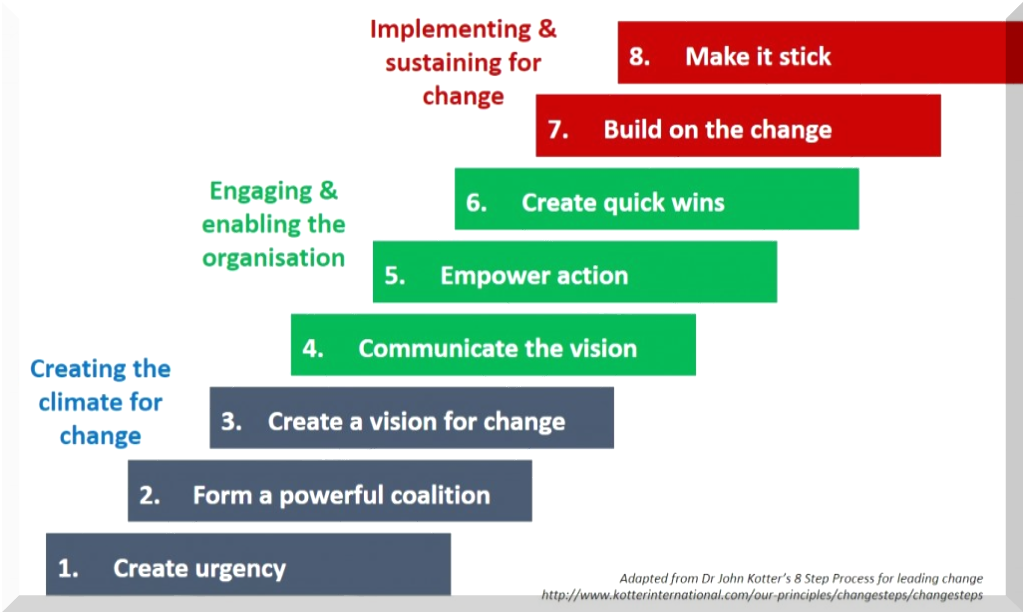
We looked in detail at the skills that a team need to make change happen. Another way of looking at change is through this very helpful model produced by John Kotter of Harvard business School.
He talks about the 8 stages. These are not necessarily sequential as sometimes we have to come back to earlier stages to reinforce them. It is helpful to think about projects that we have been involved in and to reflect on whether the 8 stages were attended to. Some stages might jump out as being more important in that project than others. We might also find that some stages seem to be missing. Was that one reason why the project was less successful then it might have been? For example, even if the change was successfully made, could it have been done quicker or with less pain?
Knowing the stages can help us to think ahead and plan for stages that we know are to come. For example, when we sell a new idea and get people on board, they are usually energised by the vision and the prospect of a better future. We might call this phase 'uninformed optimism'. However, we know that in real life, energy and enthusiasm tends to drain and there comes a stage when people start to appreciate the personal effort that a change might involve. Uninformed optimism therefore leads later to 'informed pessimism'. To a degree we can counter this by planning early on for a 'quick win', stage 6 in the Kotter model. This can help to energise and reinvigorate people just as a point when enthusiasm will be waning.
You can read much more about this model online and it pays to think about and discuss how you would achieve each stage. To make it real, try applying it to a real-life problem that is occupying you.
Here is a practical exercise to help you develop your skills at the very start of Kotter, which is to do with creating the climate for change. In this stage, we have to identify what needs changing, why, and why now.
A Fresh Set of Eyes
Many organisations, usually forward thinking businesses rather than institutions, will recognise the value of new people in the organisation and the fresh pair of eyes that they bring.
New people within the first few weeks will be asking themselves questions like:
Why are we doing this?
Why are we doing this in this way?
I've seen this problem dealt with differently (and better) elsewhere.
That's really great! Why haven't other people done it the way that you do?
Try using this mindset in your own organisation and come up with two or three suggestions for change which, to you, are priorities based on your observations. Then present these to the team and make a pitch for what needs changing and why. You will learn a lot about how to look afresh at what's going on around you, how to prioritise and make a case for change and finally, how to persuade people and win them round to either your point of view or through negotiation, to an objective that you can mutually agree on.
This exercise does a great deal for new people and makes them feel that they matter and that they have something valuable to contribute from the very earliest days.
Disclaimer:
This page draws on the Primary Colours® Model of Leadership as described by Pendleton, Furnham and Cowell (2021). The material is adapted for educational purposes within the Coventry & Warwickshire VTS programme. The frameworks and personality descriptors presented here are intended as tools to support reflection and discussion, not as definitive or prescriptive accounts of leadership. Readers are encouraged to engage critically with these ideas and consider them alongside other perspectives.
References:
Belbin, R.M. (2010) Team Roles at Work. 2nd ed. Oxford: Butterworth‑Heinemann.
Kotter, J.P. (1996) Leading Change. Boston, MA: Harvard Business School Press.
Pendleton, D., Furnham, A. and Cowell, J. (2021) Leadership: No More Heroes. London: Palgrave Macmillan.